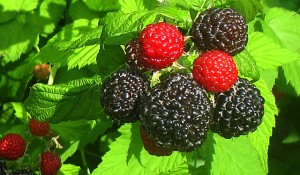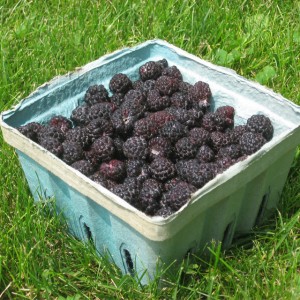What is a Black Raspberry?

The black raspberry is a delicious, small, dark purple fruit that grows predominantly in Oregon. One of the most important things to know about black raspberries is not only are they delicious and nutritious, the U.S. Department of Agriculture reports that this “King of Berries” has the highest antioxidant capacity of any fruit. They contain powerful anthocyanins which are antioxidant flavonoids that are helpful to many body systems. Black raspberries have anti-inflammatory effects (which helps combat allergies among other benefits), protects the nervous system and inhibit some tumor cell development. They have some of the strongest physiological effects of any plant compound, and they are also things of beauty: anthocyanins provide pigment for pansies, petunias, and plums.
Black Raspberries in Clinical Trials
Black raspberries are one of the few fruits that have been used in human clinical trials. These trials generally focus cancerous tumor regression due to direct exposure to the compounds found in black raspberries. The high levels of anthocyanins are important on a nutritional level, but they also give the black raspberry its incredibly dark appearance. The color of black raspberries is so intense that the USDA actually used it to stamp meat.
The black raspberry only enjoys fame in the Northwest United States and in research laboratories across the country. Many people, and even companies, get this rare berry confused with the similarly named but far more common blackberry (we will touch on the differences in our next installment).
Black Raspberry Facts
- Nicknames: Blackcap, king of berries
- Weight: 1-2 grams (it’s a very small berry)
- Color: ranges from a dark purple/red to almost black
- Location: Almost exclusively grown in Oregon. Can also be found in small quantities in states like Ohio, and in a few other countries like the United Kingdom and Korea.
- Peak Performance: Black raspberries are usually harvested during a three week window in July.
- Strengths: One of the most researched fruits in the world. High in anthocyanins and polyphenols. High in fiber and relatively low in sugar. Pretty dang healthy to eat.
- Weaknesses: Hard and expensive to grow. Low yields. Hard to find in stores. Have a good amount of seeds.
- Found in: Frozen fruit sections, freeze-dried powders and whole berries, extracts, ice cream, tea.
Of course a lot of these characteristics can change quite a lot depending quite a few variables, so with that:
Black Raspberry Variations
 When you purchase fruit from the produce section of your grocery store or local farmer’s market, you know that not all fruit is the same. For example, there are many different types of apples, and even within those specific genotypes there can be variation in quality in taste by geographic location and even by farm. The same thing applies to black raspberries! There are three major varieties of black raspberries. Wikipedia being the great source that it is has some basic information on all three:
When you purchase fruit from the produce section of your grocery store or local farmer’s market, you know that not all fruit is the same. For example, there are many different types of apples, and even within those specific genotypes there can be variation in quality in taste by geographic location and even by farm. The same thing applies to black raspberries! There are three major varieties of black raspberries. Wikipedia being the great source that it is has some basic information on all three:
- Rubus leucodermis (Native to the western North America)
- Rubus occidentalis (Native to the eastern North America)
- Rubus coreanus (Native to Korea, Japan, and China)
Over 90% of the total black raspberry production in the United States is in Oregon. Because the berries are so hard to grow, only a few places in the world produce these healthy berries. Strangely enough, Rubus occidentalis, and specifically the Munger variety, is the type of black raspberry that is grown and harvested commercially in Oregon despite being on the west coast. There are well over 20 other varieties of black raspberries being grown today. They all vary in size and also express different levels of anthocyanins as well.
While we will jump into what to look at when buying black raspberries in more detail at a later date, keep in mind that how they are grown and how they are handled and processed after being harvested as just as important as the berries themselves. The last two articles in the research section below will give you an idea of how much black raspberries can vary based on how and where they are grown, and how the nutrient levels in final products can be affected by how the black raspberries are treated after leaving the vine.
As you can see, there is quite a lot of information out there on black raspberries, and this is just the tip of the iceberg. We will continue to try and put out information we feel is helpful, but please let us know if there is a topic you would like to know about!
Research Articles of Interest
- Anthocyanins and their role in cancer prevention.
- Effect of black raspberry ( Rubus occidentalis L.) extract variation conditioned by cultivar, production site, and fruit maturity stage on colon cancer cell proliferation.
- Processing and storage effects on monomeric anthocyanins, percent polymeric color, and antioxidant capacity of processed black raspberry products.
- Antioxidant activity and phenolic content of Oregon caneberries
6 thoughts on “What is a Black Raspberry?”
Comments are closed.

I observed your blog using google and I must say, this is most likely one of the greatest nicely ready articles I have come across in a long time. I’ve bookmarked your site for more posts.
Thanks for giving us a detailed tips when it come’s to choosing the right black raspberry that suits our needs.Not just the tips but the nutrients and what benefits we user’s can avail.I can say that your article is worth staying for for I have learned a lot of new things with regard’s to black raspberry.Will definitely keep on track for more updates!
Thanks Joe! We appreciate it.
Your welcome Brian ! The pleasure is mine…